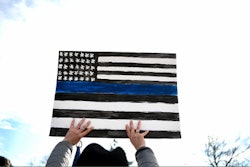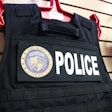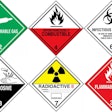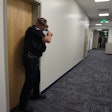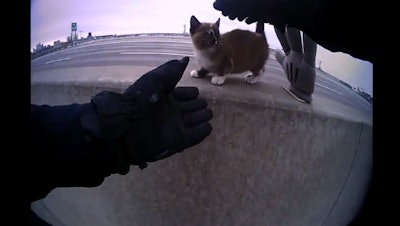 An officer with the North Kansas City (MO) Police Department coming to the rescue of a tiny kitten trapped on the Jersey barrier between the northbound and southbound lanes of an area highway.Photo: North Kansas City PD / YouTube.
An officer with the North Kansas City (MO) Police Department coming to the rescue of a tiny kitten trapped on the Jersey barrier between the northbound and southbound lanes of an area highway.Photo: North Kansas City PD / YouTube.
Twice this week, we reported on an officer adopting an animal he had rescued from a life-threatening situation.
On Monday, we reported on an event that took place late last year in which two officers with the New York Police Department came upon a dog chained to a fence, seemingly abandoned. They freed the animal and delivered it to a shelter. When one of the officers learned that the dog would be put down if not adopted, he began the adoption process himself, and now has "Joey" as his pet.
On Tuesday, we reported on an officer with the Platteville (WI) Police Department who adopted a kitten he had recently pulled from a ditch filled with about three feet of snow. He had heard the tiny animal meowing, and after locating the general area where the sound was coming from dug into the snow to rescue it from what was an all-but-certain death. He took the animal to a nearby veterinarian to have it examined. When it was found to be in good health, he elected to adopt the cat, naming it Donut.
A couple weeks ago, we saw body camera footage of a Missouri officer coming to the rescue of a tiny kitten trapped on the Jersey barrier between the northbound and southbound lanes of an area highway shortly before Christmas last year. After the officer grabbed the cat with gloved hands, the animal protested with a series of tiny "meows." Once inside the squad, however, the fuzzy little creature became far friendlier. The officer had the cat examined at a nearby veterinary clinic and adopted it.
Animal Rescue
While not all officers end up taking an animal he or she rescued into their home, there are countless incidents in which cops rescue an animal.
We've seen officers use savory snacks to lure a wayward farm animal to safety. We've seen officers wade into the Tasman Sea to rescue a drowning kangaroo. We've even seen officers help free a bear trapped in an automobile.
Deer, moose, buffalo, alligators, eagles, egrets, coyotes, bobcats, geese, dogs, cats, and even pet fish have been rescued by police officers.
When a department posts on social media news of an officer's assistance to an animal in need, the public eats it up like gourmet kibble, offering messages of thanks and praise to the individuals involved.
These are "feel good" stories that bring tremendous benefit to an agency's public perception.
However, dealing with animals can also be hazardous business—particularly when they are not domesticated, and particularly when they are trapped and/or injured. Here are some thoughts on dealing with non-human subjects in a way that keeps both the animal and the officer safe.
1. Glove Up
Any time you're about to touch or handle an animal, you should be wearing gloves. This seems obvious, but we've seen many videos of officers dealing with an animal without this basic level of protection. An officer once told me that he wears two pairs—sterile rubber gloves under sturdy leather patrol gloves.
2. Slow Going
An animal in pain or in peril is far more likely to "freak out" if the responding officer is not completely calm and deliberately slow in their movement. Any sudden move by officers coming to an animal's rescue could be construed as an attack, and bad things can happen even if the subject in question is a domesticated house cat.
3. Tranquilizer Guns
Especially in the case of wild animals that have wandered into a residential or commercial neighborhood, the ideal solution to return the creature to its natural habitat is to deploy a tranquilizer gun specifically designed to put an animal safely to sleep. Not every squad car should have this equipment, but at least a couple should, and dispatch should have a solid handle on who's driving the vehicle with the dart gun in the trunk.
4. Control Poles
Speaking of handles, the best friend of any officer approaching an animal in distress can be a control pole. Again, not every squad car needs to have this essential animal control equipment in the trunk, but having access to one of these simple devices from a responding backup officer is mighty handy in handling all manner of critter from snakes and lizards to dogs and cats.
5. Animal Control
Speaking of backup officers, if your city or town has an animal control unit—and the creature in question is contained and not posing an immediate danger—why not call in the professionals? They have all the abovementioned equipment, plus various cages and crates to contain the animal as it is transported to wherever it needs to be, whether that's a veterinary hospital, an animal shelter, or back to its natural habitat in the wild. If you don't have animal control in your city, perhaps a neighboring jurisdiction does. Call them.
6. Study Up
Especially if you're a relatively new officer on your PD, educate yourself on the types of animal calls your agency has handled in years past. The seasoned veterans will gladly tell you stories of harrowing—and at times hilarious—misadventures with the local fauna. If you're lateraling into an agency from somewhere else in the country, this is essential. The guys and gals in Florida and Louisiana have alligators, but not elk. Their counterparts in Montana and Wyoming have the exact opposite problem.
7. Last Resort
When no other alternative is appropriate, officers must be prepared to put an animal down. Astonishingly, not every agency trains for this. A few years ago I did an informal—and totally unscientific—survey of a couple dozen officers I know, and I'd estimate that about a quarter of them said they'd never been formally trained to shoot an animal. Armed with the knowledge of the most likely animals to show up in your area, you also have to know what weapon to choose—pistol, rifle, or shotgun—and where the shot should be placed.
Final Thoughts
Animal rescue is incredibly common for law enforcement. I'd venture that a dozen or more animals are rescued by American cops every single day—we really only hear about a small handful of these events.
Some animals are adopted by their rescuers—as happened in those stories from New York and Wisconsin and Missouri this month. Some are returned to their owners and others are given up for adoption at a shelter. Sadly, some are put down.
Mountain lions and other dangerous predators occasionally show up in densely populated cities. Deer and elk have been known to get tangled in a farmer's fencing. Raccoons and opossums end up in storm drains and dumpsters on a regular basis.
Be safe when dealing with animals—from kittens to cougars and iguanas to crocodiles.







